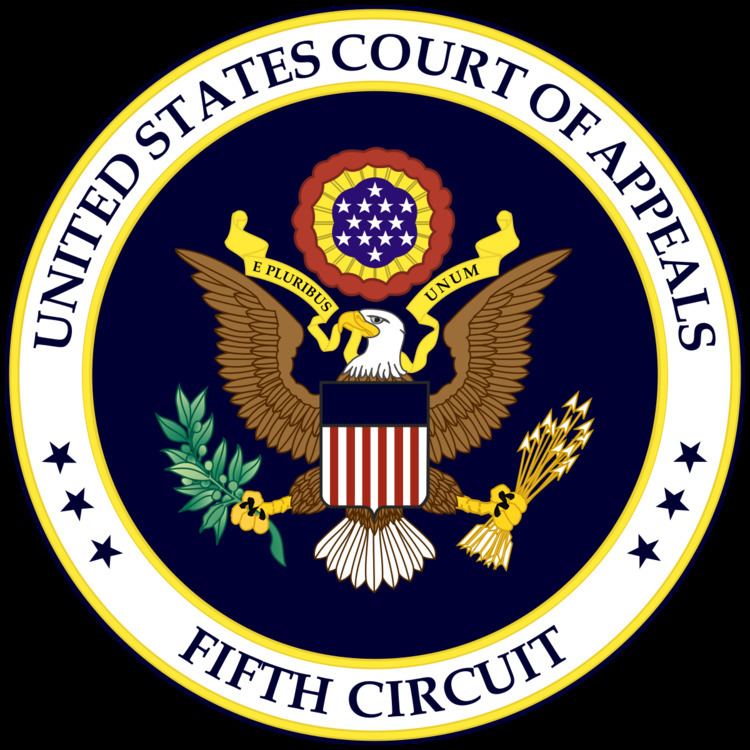Established June 16, 1891 Active judges 17 | Senior judges 8 | |
 | ||
Appeals from Eastern District of LouisianaMiddle District of LouisianaWestern District of LouisianaNorthern District of MississippiSouthern District of MississippiEastern District of TexasNorthern District of TexasSouthern District of TexasWestern District of Texas | ||
The United States Court of Appeals for the Fifth Circuit (in case citations, 5th Cir.) is a federal court with appellate jurisdiction over the district courts in the following federal judicial districts:
Contents
- History of the court
- The Fifth Circuit Four
- Hurricane Katrina
- Current composition of the court
- List of former judges
- Chief judges
- Succession of seats
- References
The court is one of 13 United States courts of appeals. Composed of 17 active judges, it is based at the John Minor Wisdom United States Court of Appeals Building in New Orleans, Louisiana, with the clerk's office located at the F. Edward Hebert Federal Building in New Orleans.
History of the court
This court was created by the Evarts Act on June 16, 1891, which moved the circuit judges and appellate jurisdiction from the Circuit Courts of the Fifth Circuit to this court. At the time of its creation, the Fifth Circuit covered Florida, Georgia, Alabama, Mississippi, Louisiana, and Texas.
On June 25, 1948, the Panama Canal Zone was added to the Fifth Circuit by 62 Stat. 870.
On October 1, 1981, under Public Law 96-452, the Fifth Circuit was split: Alabama, Georgia, and Florida were moved to the new Eleventh Circuit.
On March 31, 1982, the Fifth Circuit lost jurisdiction over the Panama Canal Zone, which transferred to Panamanian control.
The Fifth Circuit Four
During the late 1950s, Chief Judge Elbert Tuttle and his three colleagues (John Minor Wisdom, John Brown, and Richard Rives) became known as the "Fifth Circuit Four", or simply "The Four", for decisions crucial in advancing the civil rights of African-Americans. In this, they were usually opposed by their fellow Fifth Circuit Judge, Benjamin F. Cameron of Mississippi, until his death in 1964.
Hurricane Katrina
Hurricane Katrina struck New Orleans on August 29, 2005, devastating the city and slightly damaging the John Minor Wisdom Courthouse. All deadlines concerning filings were extended. The court temporarily relocated its administrative operations to Houston, but has now returned to normal operations in New Orleans.
Current composition of the court
As of January 1, 2017, the judges on the court are as follows:
List of former judges
Sixty-one judges formerly served on the court but no longer do:
Chief judges
Chief judges have administrative responsibilities with respect to their circuits, and preside over any panel on which they serve unless the circuit justice (i.e., the Supreme Court justice responsible for the circuit) is also on the panel. Unlike the Supreme Court, where one justice is specifically nominated to be chief, the office of chief judge rotates among the circuit judges. To be chief, a judge must have been in active service on the court for at least one year, be under the age of 65, and have not previously served as chief judge. A vacancy is filled by the judge highest in seniority among the group of qualified judges. The chief judge serves for a term of seven years or until age 70, whichever occurs first. The age restrictions are waived if no members of the court would otherwise be qualified for the position.
When the office was created in 1948, the chief judge was the longest-serving judge who had not elected to retire on what has since 1958 been known as senior status or declined to serve as chief judge. After August 6, 1959, judges could not become chief after turning 70 years old. The current rules have been in operation since October 1, 1982.
Succession of seats
The court has had 29 seats for active judges. Twelve of these seats were reassigned to the United States Court of Appeals for the Eleventh Circuit, leaving a seventeen-seat court. The seats are numbered in the order in which they were filled. Judges who retire into senior status remain on the bench but leave their seat vacant. That seat is filled by the next circuit judge appointed by the president.
